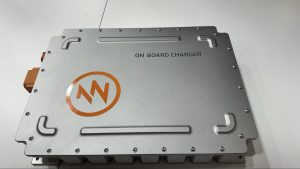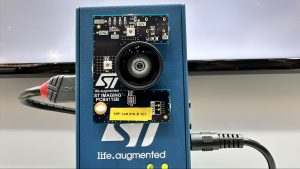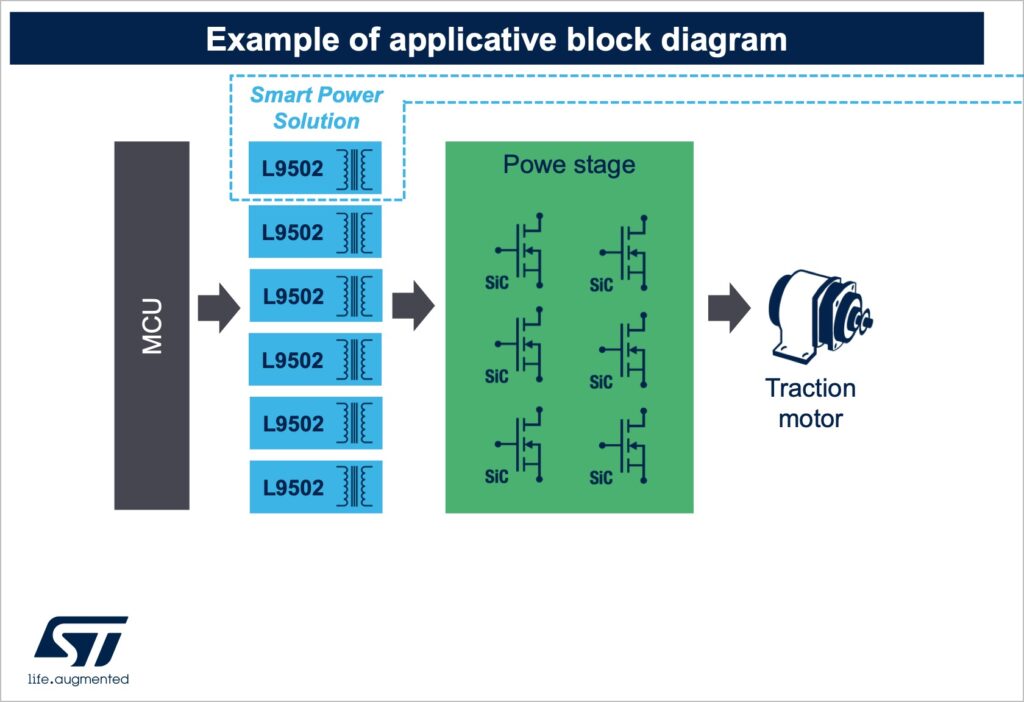
Audi OLED
The demonstration by Audi shows what type of effects a headlight can produce when using a powerful LED driver. The L99LDLH32 is a 32-channel LED driver with a CAN-FD Light interfacethat supports 4,000 light sources. Thanks to its high-precision oscillator, it doesn’t require external quartz, reducing the cost of materials. The LED driver is also fast enough to produce a bright 3D image using the headlight’s OLEDs, creating shapes to alert other drivers. For instance, the lights could display a triangle if the car suddenly breaks to warn drivers behind.
On Board Charger

The onboard charger from Innoelectric demonstrates the energy efficiency afforded by the latest transistors. The reference design features silicon carbide MOSFETs and diodes as well as IGBT devices, super junction MOSFETS, and thyristors. As a result, it can charge a car faster by delivering more energy to the battery while taking 30% less space than previous onboard chargers, thanks to its vastly better energy efficiency.
VB1940 / VD1940

The VB1940 / VD1940 demo is a driver monitoring system (DMS) and occupant monitoring system (OMS). The VD1940 is a 5.1-megapixel RGB-near infrared sensor with a resolution of (2560 x 1984). The VB1949 is identical but in an OBGA package, while the VD1940 is the die that customers acquire to put in their packaging. The demonstration simulates an in-cabin experience where the camera detects faces and their place in the vehicle.
The sensor combines RGB and near-infrared pixels to create a full-resolution image without the traditional data constraints of a full RGB sensor. The NIR data complements the RGB information to help upscale and produce a full high dynamic range (HDR) image without needing an external companion device. The sensor generates the image and sends it to the application running on the microcontroller.
Traction Inverter

The demo showcases a reference design for a modern and powerful traction inverter. In a nutshell, the traction inverter takes power stored in the battery to drive the electric motors that turn the wheel. As a result, it dramatically influences acceleration, torque, and overall driving experience. The ST design includes silicon carbide MOSFETs and liquid cooling to improve efficiency and reduce the overall footprint. It also uses the L9502 galvanically isolated gate drivers, which sit between the microcontroller (an SPC58) and the power stage using silicon carbide devices, to protect the MCU from power surges and other shocks that could damage the system. The reference design is, therefore, an example of a complete design that OEMs could adopt in their vehicle.
Energica Eva Ribelle Electric Motorbike
The Eva Ribelle is an electric motorbike from Energica that features their new EMCE (Energica Mavel Co-Engineering) motor and inverter. It’s a unique piece of engineering because instead of designing the motor and inverter separately, as is usually the case, Energica and Mabel conceived them together. They both share the same liquid cooling system and more closely interact with one another. Consequently, the inverter can better adapt to the motor’s need to optimize speed and torque. Additionally, thanks to the increased efficiency, the whole system is about 10 kg lighter, which increases range and improves drivability.
Ultimately, the Eva Ribelle can reach 0 to 60 in 2.6 seconds, climb up to 200 km/h, and provide a range of up to 420 km when driving optimally. The new motor-inverter system uses STM32 microcontrollers and the L9963 battery management system. The company also settled on ST high-side switches like the VNQ5160K-E to manage various loads, such as the headlights and blinkers.
Click Link:
https://blog.st.com/electronica-2022-behind-the-scenes-what-the-smart-mobility-live-stream-didnt-show-you/






